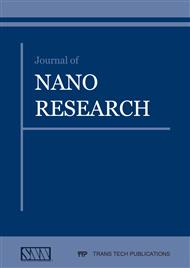[1]
S. Iijima, Helical microtubules of graphitic carbon. Nature 354 (1991) 56-58.
DOI: 10.1038/354056a0
Google Scholar
[2]
T.W. Ebbesen, P.M. Ajayan, Large-scale synthesis of carbon nanotubes. Nature 358 (1992) 220-222.
DOI: 10.1038/358220a0
Google Scholar
[3]
C.Z. Zhu, Y. Zhao, High-speed nano-bearings constructed from double-walled carbon nanotubes: Effect of flexile deformation. J. Appl. Phys. 114 (2013) 174501-174501-4.
DOI: 10.1063/1.4828871
Google Scholar
[4]
J.W. Kang, K.S. Kim, O.K. Kwon, H.J. Hwang, Linear nanomotor based on electromigration of a nanoparticle encapsulated in a carbon nanotube. J. Nanosci. Nanotechno. 11(2010)1753-6.
DOI: 10.1166/jnn.2011.3390
Google Scholar
[5]
H.Y. Chiu, P. Hung, H.W.C. Postma, M. Bockrath, Atomic-scale mass sensing using carbon nanotube resonators. Nano lett. 7 (2012) 4342-6.
DOI: 10.1021/nl802181c
Google Scholar
[6]
Q.S. Zheng, Q. Jiang, Multiwalled carbon nanotubes as gigahertz oscillators. Phys. Rev. Lett. 88 (2002) 045503-3.
DOI: 10.1103/physrevlett.88.045503
Google Scholar
[7]
S.B. Legoas, V.R. Coluci, S.F. Braga, P.Z. Coura, S.O. Dantas, D.S. Galvao, Molecular-dynamics simulations of carbon nanotubes as gigahertz oscillators. Phys. Rev. Lett. 90 (2003) 055504-4.
DOI: 10.1103/physrevlett.90.055504
Google Scholar
[8]
P. D. Sia, Oscillating velocity and enhanced diffusivity of nanosystems from a new quantum transport model. J. Nano. Res-sw. 16 (2012) 49-54.
DOI: 10.4028/www.scientific.net/jnanor.16.49
Google Scholar
[9]
W. Qiu, Y.L. Kang, Z.K. Lei, Q.H. Qin, Q. Li, A new theoretical model of a carbon nanotube strain sensor, Chinese Phys. Lett., 26 (2009) 080701.
Google Scholar
[10]
W. Qiu, Y.L. Kang, Z.K. Lei, Q.H. Qin, Q. Li, Q. Wang, Experimental study of the Raman strain rosette based on the carbon nanotube strain sensor, Journal of Raman Spectroscopy, 41 (2010) 1216-1220.
DOI: 10.1002/jrs.2584
Google Scholar
[11]
W. Qiu, Q. Li, Z.K. Lei, Q.H. Qin, W.L. Deng, Y.L. Kang, The use of a carbon nanotube sensor for measuring strain by micro-Raman spectroscopy, Carbon, 53 (2013) 161-168.
DOI: 10.1016/j.carbon.2012.10.043
Google Scholar
[12]
M. Vatani, M. Vatani, J.W. Choi, Multi-layer stretchable pressure sensors using ionic liquids and carbon nanotubes. Appl. Phys. Lett. 108 (2016) 011009-10723.
DOI: 10.1063/1.4941812
Google Scholar
[13]
A.S. Chauhan, A. Nogaret, Direct pressure sensing with carbon nanotubes grown in a micro-cavity. Appl. Phys. Lett. 102 (2013) 233507-4.
DOI: 10.1063/1.4811166
Google Scholar
[14]
J. Cumings, A. Zettl, Low-friction nanoscale linear bearing realized from multiwall carbon nanotubes. Science 289 (2000) 602-4.
DOI: 10.1126/science.289.5479.602
Google Scholar
[15]
Y.H. Zeng, W.G. Jiang, Q.H. Qin, Oscillators based on double-walled armchair@zigzag carbon nanotubes containing inner tubes with different helical rises. Nanotechnology 27 (2016) 1690-4.
DOI: 10.1088/0957-4484/27/9/095705
Google Scholar
[16]
K. Cai, H. Yin, Q.H. Qin, Y. Li, Self-excited oscillation of rotating double-walled carbon nanotubes. Nano Lett. 14 (2014) 2558-62.
DOI: 10.1021/nl5003608
Google Scholar
[17]
B. Motevalli, J.Z. Liu, Tuning the oscillation of nested carbon nanotubes by insertion of an additional inner tube. J. Appl. Phys. 114 (2013) 214302-13.
DOI: 10.1063/1.4834577
Google Scholar
[18]
V. Meunier, P. Lambin, Scanning tunneling microscopy and spectroscopy of topological defects in carbon nanotubes. Carbon 38 (2000) 1729-33.
DOI: 10.1016/s0008-6223(99)00296-1
Google Scholar
[19]
M.B. Nardelli, J.L. Fattebert, D. Orlikowski, C. Roland, Q. Zhao, J. Bernholc, Mechanical properties, defects and electronic behavior of carbon nanotubes. Carbon 38 (2000) 1703-11.
DOI: 10.1016/s0008-6223(99)00291-2
Google Scholar
[20]
R.H. Telling, C.P. Ewels, A. Ahlam, M.I. Heggie, Wigner defects bridge the graphite gap. Nat. Mater. 2 (2003) 333-7.
DOI: 10.1038/nmat876
Google Scholar
[21]
R.G. Amorim, A. Fazzio, A. Antonelli, F.D. Novaes, J.R. da Sliva Antonio, Divacancies in graphene and carbon nanotubes. Nano Lett. 7 (2007) 2459-62.
DOI: 10.1021/nl071217v
Google Scholar
[22]
R. Li, D.H. Sun, Influence of defects on friction and motion of carbon nanotube. Acta Phys. Sin-Ch. Ed. 63 (2014) 056101.
DOI: 10.7498/aps.63.056101
Google Scholar
[23]
H.Y. Song, X.W. Zha, Molecular dynamics study of effects of radius and defect on oscillatory behaviors of C60–nanotube oscillators. Phys. Lett. A 373 (2009) 1058-61.
DOI: 10.1016/j.physleta.2009.01.028
Google Scholar
[24]
P. Liu, H. J. Gao, Y. W. Zhang, Effect of defects on oscillation characteristics and instability of carbon nanotube-based oscillators. Appl. Phys. Lett. 93 (2008) 083107-3.
DOI: 10.1063/1.2976127
Google Scholar
[25]
D.W. Brenner, O.A. Shenderova, J.A. Harrison, S.J. Stuart, B. Ni, S.B. Sinnott, A second-generation reactive empirical bond order (REBO) potential energy expression for hydrocarbons. J. Phys.: Condens. Matter 14 (2002) 783-802.
DOI: 10.1088/0953-8984/14/4/312
Google Scholar
[26]
S.J. Stuart, A.B. Tutein, J.A. Harrison, A reactive potential for hydrocarbons with intermolecular. J. Chem. Phys. 112 (2000) 6472-86.
Google Scholar
[27]
H. Jiang, M.F. Yu, B. Liu, Y. Huang, Intrinsic energy loss mechanisms in a cantilevered carbon nanotube beam oscillator. Phys. Rev. Lett. 93 (2004) 10445-10458.
DOI: 10.1103/physrevlett.93.185501
Google Scholar
[28]
Z. R. Guo, T. C. Chang, X. M. Guo, H. J. Gao, Thermal-induced edge barriers and forces in interlayer interaction of concentric carbon nanotubes. Phys. Rev. Lett. 107 (2011) 516-524.
DOI: 10.1103/physrevlett.107.105502
Google Scholar
[29]
Y. Zhao, C.C. Ma, G.H. Chen, Q. Jiang. Energy dissipation mechanisms in carbon nanotube oscillators. Phys. Rev. Lett. 91 (2003) 175504-4.
DOI: 10.1103/physrevlett.91.175504
Google Scholar
[30]
L.H. Wong, Y. Zhao, G.H. Chen, A.T. Chwang. Grooving the carbon nanotube oscillators. Appl. Phys. Lett. 88 (2006) 183107-3.
Google Scholar


